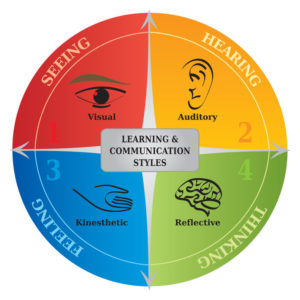By Dr. Ken Broda Bahm:

It is part of the received wisdom of popular psychology: People have different learning styles. You reach “auditory learners” by explaining it to them verbally, “visual learners” by showing them graphics, “reflective learners” by giving them something to ruminate on, and “kinesthetic learners” by having them get up and do it. Influence fails, this lore holds, when you use the wrong methods to address individuals with each of these learning styles. But is it true? Are there really these four different groups, and does effective teaching depend on using the right approach with each? The answer, explored in a recent note in Research Digest, is no, it isn’t and it doesn’t.
That finding is based on a new study, but the idea of learning styles generally has never been well supported by research. The explanation from some believers was that the support was lacking only because it had not been studied in the right settings, namely outside of classrooms where a majority of learning actually occurs. The new study (Husmann & O’Loughlin, 2018), however, directly addresses that. Researchers at the Indiana University School of Medicine took undergraduates enrolled in the famously difficult premed anatomy class, and had them take the most popular survey to diagnose their supposed learning styles, the VARK, and then to adapt the study approach most appropriate to their style. After assessing to see if the students did indeed revise their study approach, the researchers checked on whether it made a difference. According to Research Digest, The results are bad news for advocates of the learning styles concept. Student grade performance was not correlated in any meaningful way with their dominant learning style or with any learning style(s) they scored highly on.
Instead of the key being a match between learning style and learning approach, it turned out that there were some study approaches that predicted better performance no matter what the learning style (e.g., for premed anatomy, it is microscope work and reviewing lecture notes). According to the researchers, the results “provide strong evidence that instructors and students should not be promoting the concept of learning styles for studying and/or for teaching interventions. Thus, the adage of ‘I can’t learn subject X because I am a visual learner’ should be put to rest once and for all.”
This has two levels of implications for legal persuaders, one having to do with how we deal with popular science, and the other having to do with how we adapt to learners.
Lesson One: Take Popular Social Science With a Grain of Salt
The hard fact is that findings from the softer sciences don’t always become popular due to the reliability or validity of their conclusions. Often notoriety comes when a finding jibes with what we expect, stands out as very odd, or seems useful in some way. That means that popular social science can end up, to use Stephen Colbert’s neologism, more “truthy” than true. So when dealing with popular explanations of science — and yes, I include this blog in that — some skepticism is always in order.
Ask, “What research is this based on?” And, even when a finding is based on credible research, remember that research itself is part of an evolving process: The answers we hold to today are likely to be revised and updated in the future, because that’s the way science works. That doesn’t mean you should disregard the science and just trust your gut instead. But it does mean you should pay attention to the foundations, and stay tuned to recent developments.
Lesson Two: Use All Styles to Adapt to Learners
Viewed more practically, the failed proof regarding the learning styles idea serves as a reminder not to overdetermine your audience. In other words, persuaders should be careful about looking at an audience member and thinking,”You are X-kind of person, so I will address you with X-kind of appeal…” That attitude reduces the audience to just one dimension. Instead of a narrow strategy aimed at a single feature, advocates will generally be better served by a broader approach that emphasizes variety and flexibility. Where the idea of learning styles remains useful is as a template for the general ways that all of us learn. And the take-away for lawyers wondering what approaches to use to reach a particular jury or judge is, “Use them all…or use as many as you’re able to.”
For that, the list of learning styles can be a useful reminder:
- Promote everyone’s visual learning through regular use of graphics.
- Promote everyone’s auditory learning through clear explanation and strong themes.
- Promote everyone’s kinesthetic learning by encouraging jurors to walk through the steps and stages of their decision.
- Promote everyone’s reflective learning by posing questions that jurors will answer on their own.
Other Posts on Learning:
- Inoculate by Teaching the Technique and Not Just the Error
- Adapt to Information Engagement Styles
- Overlearn Your Deposition
Husmann, P. R., & O’Loughlin, V. D. (2018). Another nail in the coffin for learning styles? Disparities among undergraduate anatomy students’ study strategies, class performance, and reported VARK learning styles. Anatomical sciences education.
Image credit: 123rf.com, used under license